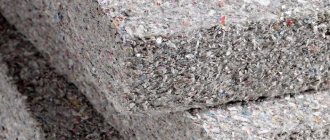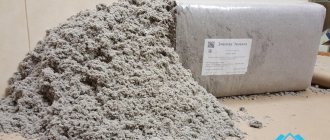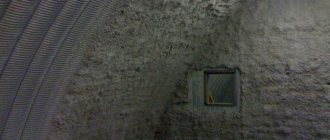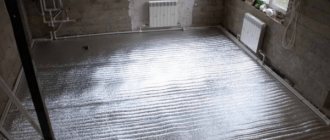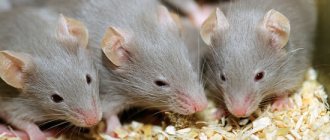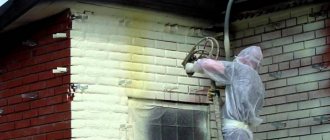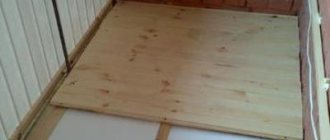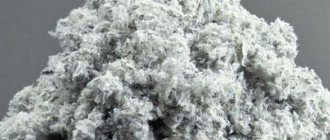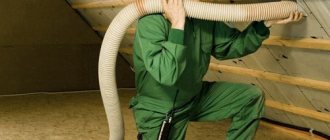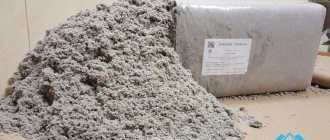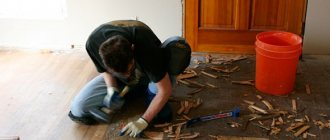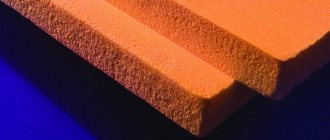What is ecowool?
Before making a choice in favor of ecowool, you should understand what kind of material it is and what it consists of. It is made from waste paper. The consistency is loose, the material is light in weight, and is produced with the addition of substances that prevent combustion and decomposition. Only through their inclusion and impregnation do the fibers acquire durability and avoid rapid destruction. Durability and fire safety are achieved by adding borax and boric acid. Borax affects the fire hazard and increases the safety class to G2, thus the material is used for insulating roof structures, facades, interfloor ceilings and floors of buildings. But its use for insulating air ducts of gas boilers and passages from solid fuel combustion chambers is prohibited. Boric acid prevents the penetration of rodents, rot and fungi. Unlike mineral wool and basalt slabs, in this material there are rarer cases of their penetration and development.
Technical characteristics of ecowool.
The structure of the material is a single mass of long fibers that can ensure the creation of a single and seamless layer of insulation, without the formation of cold bridges. Its application into the interfloor flooring ensures reliable and dense filling of the space and protection of the more vulnerable part of residential premises - the floors.
Thanks to its high technical properties (thermal conductivity reaches 0.040 W/mK) and adjustable density (from 25 to 95 kg/m³), ecowool is not very different from other good thermal insulation materials - mineral or basalt wool, extruded insulation. But there are several parameters that still make it stand out against the general background.
Ecowool insulation: material characteristics
Advantages of ecowool
The material is also called thermoflock and uniol. Cellulose in its composition occupies the predominant share - 81%. This material has excellent thermal insulation characteristics; its use allows you to create a seamless monolithic layer. But in its pure form it cannot be used in construction work, since it is very flammable, easily ignites, and is susceptible to the influence of various biological factors.
Adding useful fillers helps correct these characteristics. It is 7% borax and 12% boric acid. What do these components provide?
Borax is a reliable fire retardant, helping to reduce the flammability and fire hazard of the base material. Of course, to a certain extent. It is, of course, not recommended to insulate chimneys and heating boilers with such an insulator, but it is extremely good for interfloor coverings and walls.
How ecowool briquettes are packaged
Boric acid has a different function. It ensures that the material loses its attractiveness to various micro- and macroorganisms: rodents, fungi and mold. Its use guarantees ecowool protection from rodents better than that of mineral wool or polystyrene foam (it must be said that they even like the latter). The material also contains a certain amount of lignin, thanks to which the smallest particles of ecowool tightly bind to the surface of the insulated structure when moistened.
In what form is ecowool produced for insulation? This is a loose, unshaped mass consisting of cellulose fibers. It is compressed to a density of 110 kg/cubic meter. meter and briquetted, facilitating loading, transportation and storage. To be used, the material must be unpacked and fluffed to such an extent that its volume has approximately quadrupled.
Main performance characteristics:
- Flammability class - G2, moderate;
- Thermal conductivity coefficient – 0.037 – 0.042;
- Vapor permeability indicator – 0.3 mg/g;
- Mounting density – 26-95;
- Density – 40 g/meter cubed;
- Smoke generation – moderate D2;
- Flame spread over the surface – 0.
Advantages and disadvantages of ecowool floor insulation
The material has numerous advantages, thanks to which it is very popular among users:
- The product is multifunctional. A layer of substance on the ceiling of a multi-story building not only insulates it, but also soundproofs it.
- The fibrous structure adheres well to any surface. It forms an elastic mass that, when installed correctly, does not sag.
- The material is impregnated with antiseptics that are destructive to fungus and mold. Mice do not live in the insulating layer.
- It retains its qualities even at 20 percent humidity, and no vapor barrier is required when laying on the floor.
- Cold bridges never remain in cotton wool. The mixture is supplied in a hose under pressure and fills all voids.
- Working with the substance does not require personal protective equipment.
- Installation of the product is carried out in the shortest possible time.
- Insulation requires a small amount of wool - 28-65 kg/m3.
- After insulation there is no need to wait for the raw materials to dry. Finishing can be done immediately after applying the substance. In addition, it is allowed to work at any temperature and humidity.
- The use of special devices allows you to quickly cover large areas.
Thermal insulation of ceilings with cellulose has a number of disadvantages that the home owner should be aware of:
- Before insulating floors with ecowool, the installation site must be carefully prepared. Preliminary work takes a lot of time.
- The substance is made from waste paper, but the technology is quite complex, so its final cost is much higher than products for a similar purpose. In addition, the insulation process requires special expensive equipment.
- Despite the presence of antipyrine in the substance, under the influence of an open fire, cotton wool begins to smolder. To avoid trouble, it is not recommended to use it in fire hazardous areas. Places near the stove should be protected with asbestos or basalt mats.
- Over time, the cotton wool shrinks, so it is filled with a reserve.
Preparing the base
Insulating the floor in a private country house is not a difficult task at all if you follow some rules. The optimal thickness of the insulating layer should be at least 20 cm. This is enough to minimize heat loss. However, in regions with cold winters, insulation up to 30 cm thick is installed in the floors.
Typically, in private houses, logs are assembled from boards measuring 20x5 cm. The distance between the logs is 60 or 40 cm, depending on the floor covering and expected loads.
OSB sheets or boards treated with an antiseptic are attached to the bottom of the joists to prevent ecowool from shedding. Then, using a stapler, a layer of windproof film is mounted with the rough side up to the heat-protective material. The membrane is laid in rows with a 15 cm overlap.
When insulating an old floor with ecowool, preliminary preparation is also required. Under the structure it is necessary to provide protection against crumbling. To do this, boards or OSB sheets are attached to beams or joists. Insulating material is blown through the holes in the subfloor covering. The size of the holes must be no less than the diameter of the blower hose.
Dry technique
If it is necessary to insulate a frame house, underground space, ceiling, etc., then the heat insulator is applied using a dry method. For this method of laying ecowool, it is necessary either to have a closed cavity or to place the insulated surface horizontally.
Base waterproofing
A typical example of the implementation of the dry method is floor insulation with ecowool.
The work is carried out according to the following scheme:
- Cut-off waterproofing is laid on the base - bitumen mastic, roofing felt, membrane or thick polyethylene.
- A floor frame is mounted on top of the waterproofing - a system of joists supported by adjustable posts or cranial bars.
Blowing material
- Cellulose fiber is blown into the gaps between the joists using a special compressor. In this case, the volume of material is calculated so that the upper boundary of the insulation layer is slightly higher than the upper edge of the joist. This will avoid excessive compaction of ecowool when laying the covering.
It’s not worth saving - slight shrinkage is still typical for the material, so there is a risk that over time large voids will form under the floor.
Covering of boards over a layer of insulation
- A subfloor made of boards or plywood is laid on top of the insulated joists. Laying a vapor barrier membrane is not required.
The method of thermal insulation of walls differs from floor insulation in a slightly greater complexity:
- First, the frame is sheathed, with continuous vertical cavities remaining between the posts, not separated by horizontal partitions.
- To access the insulated cavity, either a special hole is made or a small fragment of the sheathing is not installed.
Blowing through holes in plasterboard sheathing
- As an alternative to sheathing, membranes (Tyvek and analogues) can be mounted on the frame, forming closed cavities and preventing the insulation from crumbling.
- The injection device hose is inserted into the hole in the upper part of the cavity. Ecowool is fed through it, which fills all the free space layer by layer.
Dry method of laying ecowool
This installation method is the most suitable for floor insulation.
Main stages
Wooden floor insulation scheme.
If the house already has a concrete subfloor, it is waterproofed. The material can be roofing felt or polyethylene film. After this, logs are installed. The distance between them should be 60 cm, which corresponds to the size of the ecowool briquette. If there is no concrete floor and the logs are installed on posts, they are hemmed underneath with boards or plywood to create a box for ecowool. In both cases, ecowool is located between the joists, so it will not experience stress.
The insulation briquette is opened, the contents are poured into a container and loosened with a mixer. The volume of material increases several times. The joists and base are moistened with water from a spray bottle. This ensures ecowool adheres to them, which improves thermal insulation. The loosened mass is poured between the joists, slightly above their level. Then the mass is compacted. If the thickness of the insulation is significant, it must be covered in layers, compacting each one. You should not compact it too much, as in this case the thermal insulation will be ineffective.
Related article: Using tiles in a wooden house: do-it-yourself installation
The ecowool surface should be moistened with a spray bottle. In moistened ecowool, the structure changes and a denser surface layer is created. Ecowool contains virtually no volatile components, but to prevent dust from spreading through the plank floor, a vapor barrier film or geotextile should be laid before laying it. The recommended thickness of the ecowool layer is at least 15 cm at air temperatures in winter down to -20 degrees. For regions with lower temperatures, the layer thickness should be increased by 1 cm for every degree.
Advantages of the method:
- work can be carried out at any temperature;
- you can do the work yourself.
Flaws:
- the work is labor-intensive;
- You need to work in a respirator.
Ecowool floor insulation technology
As a rule, the floor design with some non-fundamental differences looks like this:
- The base of the floor is filled with concrete mortar or remains earthen;
- Next, the subfloor is made up of wooden logs;
- The bottom side is lined with a vapor barrier film (this option is required if the floor is earthen);
- The underside of the subfloor can be additionally covered with a layer of moisture-resistant plasterboard;
- Ecowool is manually poured on top without tamping (see below for the mechanical method of blowing);
- A finishing layer of floorboards, OSB, DSP or laminate is laid on top of the wooden logs and insulation;
- When mechanically blowing ecowool, special technological holes are used in the floor, which has already been laid with the top finishing layer. After the insulation is blown into the cavity between the joists, the technological holes are closed.
This technology allows for seamless insulation of the floor of a country house. Ecowool fills the entire space, covering all communications and electrical cables laid along the base of the floor. After insulation, there are no gaps left between the communication elements and the floor.
Ecowool belongs to the G-2 flammability class and, if wiring in the floor catches fire, it prevents the spread of fire, since it does not burn, but smolders.
Cellulose insulation is not suitable for insects and rodents due to their intolerance to the natural component - borax. This gives the home additional comfort and sanitary safety.
Selection of equipment for installation of ecowool
Before laying, the raw materials must be fluffed to a uniform consistency. Only in this state does it have the necessary insulating characteristics. Mechanization of the process involves the use of special devices that automatically loosen the material and supply it along with air through the pipe to the ceiling.
A typical blow molding device design looks like this:
- Platform on which the engine, gearbox, blower and other components are mounted.
- Electric motor with gearbox - can be two or three stages. This scheme allows the buyer to choose products based on performance and power. Typically, the power plant operates on a low current, which ensures the machine is silent and durable.
- Gateway - designed to capture cotton wool and fluff it up. From it the working mass is fed into the hose.
- Funnel - for loading material into the device.
- Damper - allows you to regulate its flow into the gateway.
- Baking powder - fluffs the compressed substance.
- Remote control - to control the installation. In many products, you can change the speed of movement of biomass and its supply remotely.
- Emergency switch - for quickly stopping the machine.
At the site for insulating floors from below - introductory remarks
Good afternoon, dear friends, my name is Vitaly - the founder, one of the managers, and also an expert in the construction and insulation of various structures. This video is a step-by-step instruction on how to insulate ecowool floors without a vapor barrier membrane. Therefore, we strongly advise you to watch it to the end, understand the principle, and ask a question if something is unclear. I, of course, am not the host of a popular channel on Russian TV, but I will try to tell and show you how we prepare and directly insulate with ecowool. Stay tuned because in the next few minutes you will see a workflow from dismantling the old insulator to pumping in cellulose material with antiseptic additives. Go!
Advantages of mechanized insulation
Professional equipment is used to insulate the floor with ecowool. The operator smoothly moves the sleeve, ensuring uniform application of ecowool.
Mechanized installation has a number of advantages compared to manual installation:
- Manual labor for carrying material to insulated structures is eliminated;
- The blowing machine fills all hard-to-reach areas and crevices with material;
- A layer of insulation without seams, differences in thickness, with uniform density;
- Thermal insulation does not shrink due to the high density of the layers.
This is interesting: the process of insulating an ecowool area of 100 m², 20 cm thick, manually takes approximately two days. Continuous installation using blow molding equipment lasts 2.5 hours.
To make floor insulation with ecowool as effective as possible, use a professional that not only produces GreenWool insulating material, but also carries out installation using specialized equipment.
The insulation process is not limited to simply applying material to the surface. This also includes a set of related works:
- Assessment of the condition of the object;
- Recommendations to the customer on choosing the method of installing ecowool, the optimal layer thickness, taking into account the specifics of the design;
- Selection of insulating materials to provide protection against moisture penetration into the insulation: steam and waterproofing membranes.
The installation of ecowool on site is carried out by a team of two operators. Our specialists have been trained to work with blow molding machines and have at least 20 years of experience in this field.
Insulation of floors with ecowool is carried out using imported equipment with a productivity of up to 1270 kg per hour, depending on the volume of work. For effective and high-quality thermal insulation, the machines are equipped with additional accessories: hose attachments, adapters, nozzles. This allows you to insulate complex structures and hard-to-reach places.
Professional installation using specialized equipment will guarantee high energy efficiency of a home, industrial facility, administrative building, or other facility.
Ecowool: main characteristics
Ecowool is a lush mass, the structure resembles construction wool. Has a gray color. Doesn't smell. When heated, it does not emit harmful substances. It is considered one of the most environmentally friendly and safe materials for humans and animals.
Thermal insulation made from ecowool has a number of advantages over other materials.
- In cold and humid climates, it lasts longer than synthetic products. The guaranteed service life of the insulation is up to 65 years.
- During operation, ecowool adapts to the ambient temperature. In winter, a house insulated with it is warm, in summer it is cool.
- Rodents and insects do not like it, and mold does not grow in it.
- Ecowool insulation perfectly absorbs noise and serves as an excellent means of sound insulation.
- The product is light in weight, easy to transport and install.
- The mass fits tightly into the place allocated to it, without forming voids.
- During operation, it does not cake for a long time.
- Minimum consumption of cellulose mass – 28-65 kg/m3
- Ecowool insulation is carried out in any weather, regardless of the time of year. There is no need to wait for the thermal insulation layer to dry. After applying the material, you can lay the finishing sheet.
These characteristics are determined by the component composition of the material. It is made from the following elements:
- cellulose extracted from waste paper processing;
- flammable agent (fire retardant);
- antiseptic (boric acid).
Cellulose is a hygroscopic material. Therefore, thermal insulation made from ecowool is not afraid of moisture. It can absorb up to 14% of liquid and release it through evaporation. Ecowool itself does not deform and does not lose its heat-retaining qualities. When renovating a floor, you can save on hydro- and vapor barrier materials.
They sell insulation in 2 forms: compressed briquettes of standard sizes and loose mass packaged in bags in a slightly compacted form. Before use, you need to beat it to give it fluffiness.
Ecowool insulation has disadvantages that you need to know about before purchasing and using it.
- The material undergoes complex technological processing in production. Most of it consists of natural ingredients. This determines its high cost compared to synthetic insulation.
- To install ecowool over large areas using a mechanized method, special expensive equipment is required.
- Ecowool insulation does not burn, but smolders. Floors around stoves and fireplaces should be additionally covered with fireproof sheets.
- The material is characterized by high flowability and low density, so the base for it must be solid, no floating structures.
Reviews from craftsmen and amateurs say that working with cellulose material is not difficult. A special video shows how to apply ecowool thermal insulation to a wooden deck or concrete base in different ways. Therefore, you can install it yourself with strict adherence to technology.
General principles of thermal insulation
The correct technology for thermal insulation of floors consists of five main stages:
- dismantling old floors;
- installation of rough (technical) floor;
- laying insulation and securing it;
- laying a hydro-vapor barrier over the insulation;
- installation and securing of the finished floor.
Each specified stage must be carried out with the utmost care. If errors are made during the installation process, correcting them may require large amounts of time and money. Therefore, it is not recommended to carry out work without prior preparation, in a hurry and without due care.
Calculation of the amount of insulation and the density of its layer
When insulating the floor of interfloor ceilings, it is necessary to remember that the thickness of the layer of material should be 10-20 centimeters, and for the lower and upper floors - 20-30 centimeters. Density with manual open filling is 30-35 kg/m3, with mechanical blowing into a closed cavity - 40-45 kg/m3, and with mechanical open application the density is 35-40 kg/m3.
The mechanical method of blowing ecowool (between the joists) makes it possible to guarantee that the entire internal space of the floor is filled without leaving seams in it. This method allows you to achieve the optimal density of the ecowool layer and give it maximum thermal insulation characteristics.
Necessary equipment for installation of ecowool
The main disadvantage of ecowool is the use of expensive equipment, which not everyone can purchase for domestic use.
In the process of laying the material you will need:
- attachment for a drill or mixer to loosen the material;
- container in which loosening will take place;
- personal protective equipment and gloves to protect hands and respiratory organs from small particles of material.
Having weighed all the advantages (low cost of the material, waste-free and easy installation), we can conclude that ecowool is an excellent way to insulate a residential building.
A few words about the design features of the structure
Hello again, dear subscribers. Now we are in the underground. This is a basement room. The house consists of two separate parts - the first is small, it is something like a warehouse or boiler room. The second part of the structure in question is the space under the floor covering with a height of approximately 700-800 millimeters (by eye), where our guys have already begun dismantling work - they remove the lower elements and remove the vapor barrier film. Everything here was covered in garden cellophane. It covered logs, floors, beams, and other structural parts. Using cheap film is a homeowner's mistake. This material is not intended to solve such problems, because it promotes the accumulation of condensation.
Garden film and PPS boards
What was here after the film matter? I'm showing you! The owner laid PPS slabs here. For those who don’t know, this is ordinary polystyrene foam in square or rectangular blocks. Pay attention to how they are laid (see video) or the image below in the text. There are holes and cracks ranging from one to twenty millimeters in size everywhere. For obvious, objective reasons, this material does not bring any benefit. It just hangs there, taking up space. Next there is a rough board about five centimeters. In my hands you see a slab 2.5 centimeters thick - a value that is extremely insufficient for thermal insulation work. We will not break the lower, rough part, but we will move it to the side by 3-5 centimeters.
Glassine as a vapor barrier
The space between the lower and upper parts is occupied by some kind of roofing material - the so-called glassine. It functions as a vapor insulator and also provides support for slag, basalt, and stone wool. Glassine is a flammable material. It is strictly not recommended to use it in insulating residential buildings. In the West, by the way, as far as I know, it is officially prohibited for use. Correct me (the author) if I'm wrong. We take a knife and open the canvas to see what else the insulating pie of this house consists of. See for yourself. There is URSA glass wool here. As soon as I touched it, I was already itching. What do you think, boys and girls, what density of insulator is here? Two, maximum three centimeters, pay attention to the picture below.
Glass wool as the main insulation
The generally accepted standard for floor insulation in a wooden cottage is two hundred millimeters. As you understand, this is the norm. We are short of it, according to the most conservative estimates, from one hundred seventy to one hundred eighty millimeters. Horror! For obvious reasons, remove the glass wool, collect it in bags and throw it away. Upon completion of the work, the guys will take the garbage and solid waste to a nearby landfill, but let’s not be distracted from the main topic. Next, we again have garden film - a material that is categorically unacceptable for use. Why? Because in this case the house turns into some kind of glass jar. We put it on the ground, wait thirty minutes and get a great amount of condensate in milliliters.
Lack of ventilation and risk of moisture formation
Moisture is an insidious and very strong enemy of wood. It destroys the structure, forming condensation, causing the appearance of fungal deposits and moldy areas. In the example of this house, film building materials practically eliminate the free movement of air. If there were no vents here, we would have faced additional difficulties in preparing the structure for blowing in ecowool. I would like to note that there is a forced ventilation system for the room - a small one, but still a plus. It is advisable to replace garden fabric (film) with a vapor barrier membrane. I'll talk about this a little later. Do not switch the video clip, watch further. Don't forget to like it by clicking on your thumb, and also subscribe to the YouTube channel "Ekovata-MSK".
Ecowool and other heat insulators
When choosing what is best to use for insulating a house, it is important to evaluate the features of the most popular thermal insulation materials. And here we will have to make a decision about what will be used - ecowool or basalt insulation, fiberglass or polystyrene foam.
Comparative energy efficiency is very high
Unlike polystyrene (pictured), ecowool is not damaged by rodents
To compare materials, you can use the table:
| Parameter | Glass wool | Plates based on basalt wool | Expanded polystyrene | Ecowool |
| Thermal conductivity, W/(m*0С) | 0,043 | 0,047 | 0,05 | 0,04 |
| Density, kg/m3 | 15 | 37 | 25 | 35 |
| Vapor permeability | High | High | Low | High |
| Biological resistance | Does not rot, is not damaged by rodents | Does not rot, may be slightly damaged by rodents | Does not rot, severely damaged by rodents | Does not rot, is not damaged by rodents |
| Fire safety | The fiber itself does not burn, but the binder may melt, releasing toxic smoke. | Does not burn; when heated strongly, it can release decomposition products of the binder | Actively melts with the release of large amounts of toxic smoke | Does not ignite, dies out quickly, and when exposed to an open flame it smolders, emitting relatively harmless smoke. |
The special structure of the fibers ensures the preservation of heat-saving qualities when moistened
As you can see, it is not possible to make a clear choice as to which is preferable – ecowool or mineral wool. The material we are considering may well compete with insulation based on mineral fiber, surpassing them in some parameters, and inferior in others.
Heat resistance comparison
From this comparison we can draw a fairly simple conclusion: the decision to use ecowool or other material is best made after a comprehensive analysis of the conditions. This insulation is quite effective, so the main factors of choice will be its availability in the region and the cost of thermal insulation work.
Calculation of average insulation thickness
Many homeowners don't fully appreciate the importance of insulation. Meanwhile, properly selected insulation can save up to 30% on heating costs.
Particularly high savings can be achieved through the use of a heated floor system. It must be insulated from below so that it does not transfer heat to the floors or the ground.
Choosing the insulation that is best suited for your home is only half the battle. The main thing is that its thickness provides the maximum possible thermal insulation. The fact is that even the best insulation will not be able to provide effective thermal insulation if it is not laid in a sufficiently warm layer. But an excessively thick layer will reduce the volume of the room.
When choosing a thermal insulation material and the required thickness, it is necessary to be guided by the climatic indicators of the place where the house is being built. These data can be found in the following regulatory documentation.
It is impossible not to take into account the design features of the house. For example, in areas with a cold climate, especially if the base of the house is not insulated, then it makes sense to lay insulation with a thickness of 150 - 200 mm. In areas with a temperate climate, a layer of insulation 100 mm thick is sufficient.
In fact, the thickness of the insulation in a house located in Crimea will be significantly less than that built in the Krasnoyarsk region.
Technology for laying ecowool in floor construction
- Ecowool is laid in the floor structure between the joists. There is no need to use rubber protective gloves for work; cotton gloves are sufficient.
- Ecowool is poured between the joists onto a pre-laid roll vapor barrier or hemming sheet material.
- The poured ecowool is slammed down with a stiff brush or compacted in any other available way. The volume of ecowool should be 10% greater than the filled volume.
- After drying, the ecowool is covered with glassine and further planning of the floor is carried out.
